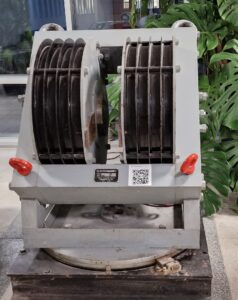Manufacturer – JEOL (Japan) 1963
Magnetic field – 0.8 T
Pole distance – 70 mm
Pole diameter – 200 mm

One of the main research areas of the physics sector established in 1961 at the Institute of Cybernetics became the development of radio spectroscopy, including the creation of the necessary state-of-the-art equipment. The head of sector Endel Lippmaa’s previous experience of building a nuclear magnetic resonance (NMR) spectrometer at TPI showed that manufacturing suitable magnets in local conditions is extremely troublesome and time-consuming. Therefore, Lippmaa considered it essential to buy the necessary magnets in ready-made form. Thus, two high-resolution NMR spectrometer magnets with fields of 0.94 T and 1.41 T were purchased from the Japanese company JEOL. This electron-paramagnetic resonance (EPR) spectrometer magnet was obtained somewhat later from Moscow, where no application was found for it.
On the basis of a 0.94 T magnet, an NMR spectrometer operating at 40 MHz was built for the study of double resonance proton spectra. It was used later also for the first solid body MAS (magic angle spinning) experiments. Using the 1.41 T magnet a spectrometer capable to measure weak signals of heteronuclei was created, which was unique in Eastern Europe at the time. The spectrometers were successfully used in various NMR research projects for more than 10 years. Based on the results of the studies, several dissertations have been defended and numerous publications have been published.
The magnet of the EPR spectrometer has never used for its original purpose. At the beginning of the 80s, an ion cyclotron resonance (ICR) spectrometer was built on its basis. A high vacuum system was created, an ICR cell and the necessary electronic blocks were designed. The Nicolet minicomputer NIC-1085 was used to register and process the spectra using the FT (Fourier transform) method [3]. Various gas-phase ion-molecular reactions were investigated, the results of which are reported in publications [1, 2].. Later, ICR research switched to a superconducting magnet spectrometer.
A unique NMR experiment was also performed on this magnet, the aim of which was to study the effect of the gravitational force on the Larmor frequency. An original fast-rotating toroidal TMR sensor was built to increase the gravity acceleration. Unfortunately, it was not possible to detect a frequency shift due to gravity within the capabilities of the test equipment.